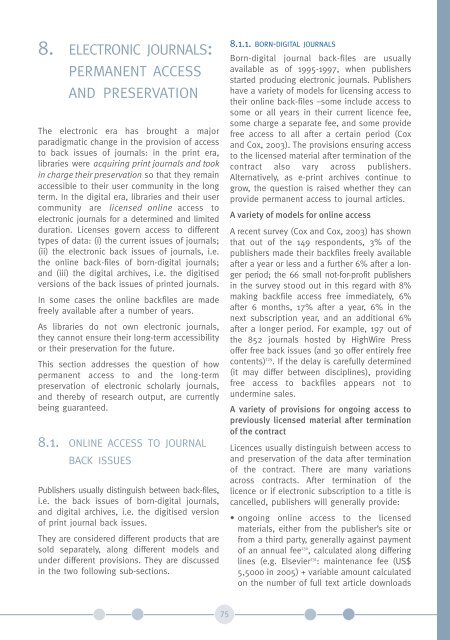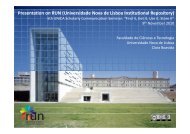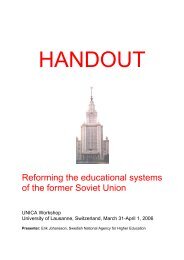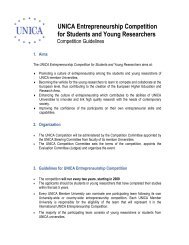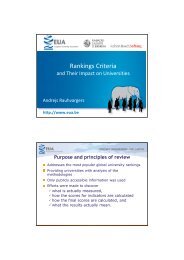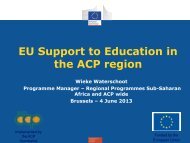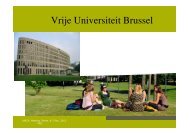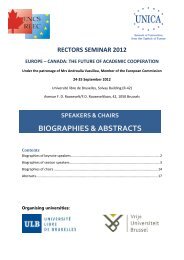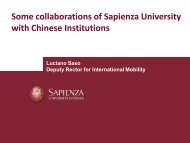Study on the economic and technical evolution of the scientific ...
Study on the economic and technical evolution of the scientific ...
Study on the economic and technical evolution of the scientific ...
Create successful ePaper yourself
Turn your PDF publications into a flip-book with our unique Google optimized e-Paper software.
8. ELECTRONIC JOURNALS:<br />
PERMANENT ACCESS<br />
AND PRESERVATION<br />
The electr<strong>on</strong>ic era has brought a major<br />
paradigmatic change in <strong>the</strong> provisi<strong>on</strong> <strong>of</strong> access<br />
to back issues <strong>of</strong> journals: in <strong>the</strong> print era,<br />
libraries were acquiring print journals <strong>and</strong> took<br />
in charge <strong>the</strong>ir preservati<strong>on</strong> so that <strong>the</strong>y remain<br />
accessible to <strong>the</strong>ir user community in <strong>the</strong> l<strong>on</strong>g<br />
term. In <strong>the</strong> digital era, libraries <strong>and</strong> <strong>the</strong>ir user<br />
community are licensed <strong>on</strong>line access to<br />
electr<strong>on</strong>ic journals for a determined <strong>and</strong> limited<br />
durati<strong>on</strong>. Licenses govern access to different<br />
types <strong>of</strong> data: (i) <strong>the</strong> current issues <strong>of</strong> journals;<br />
(ii) <strong>the</strong> electr<strong>on</strong>ic back issues <strong>of</strong> journals, i.e.<br />
<strong>the</strong> <strong>on</strong>line back-files <strong>of</strong> born-digital journals;<br />
<strong>and</strong> (iii) <strong>the</strong> digital archives, i.e. <strong>the</strong> digitised<br />
versi<strong>on</strong>s <strong>of</strong> <strong>the</strong> back issues <strong>of</strong> printed journals.<br />
In some cases <strong>the</strong> <strong>on</strong>line backfiles are made<br />
freely available after a number <strong>of</strong> years.<br />
As libraries do not own electr<strong>on</strong>ic journals,<br />
<strong>the</strong>y cannot ensure <strong>the</strong>ir l<strong>on</strong>g-term accessibility<br />
or <strong>the</strong>ir preservati<strong>on</strong> for <strong>the</strong> future.<br />
This secti<strong>on</strong> addresses <strong>the</strong> questi<strong>on</strong> <strong>of</strong> how<br />
permanent access to <strong>and</strong> <strong>the</strong> l<strong>on</strong>g-term<br />
preservati<strong>on</strong> <strong>of</strong> electr<strong>on</strong>ic scholarly journals,<br />
<strong>and</strong> <strong>the</strong>reby <strong>of</strong> research output, are currently<br />
being guaranteed.<br />
8.1. ONLINE ACCESS TO JOURNAL<br />
BACK ISSUES<br />
Publishers usually distinguish between back-files,<br />
i.e. <strong>the</strong> back issues <strong>of</strong> born-digital journals,<br />
<strong>and</strong> digital archives, i.e. <strong>the</strong> digitised versi<strong>on</strong><br />
<strong>of</strong> print journal back issues.<br />
They are c<strong>on</strong>sidered different products that are<br />
sold separately, al<strong>on</strong>g different models <strong>and</strong><br />
under different provisi<strong>on</strong>s. They are discussed<br />
in <strong>the</strong> two following sub-secti<strong>on</strong>s.<br />
8.1.1. BORN-DIGITAL JOURNALS<br />
Born-digital journal back-files are usually<br />
available as <strong>of</strong> 1995-1997, when publishers<br />
started producing electr<strong>on</strong>ic journals. Publishers<br />
have a variety <strong>of</strong> models for licensing access to<br />
<strong>the</strong>ir <strong>on</strong>line back-files –some include access to<br />
some or all years in <strong>the</strong>ir current licence fee,<br />
some charge a separate fee, <strong>and</strong> some provide<br />
free access to all after a certain period (Cox<br />
<strong>and</strong> Cox, 2003). The provisi<strong>on</strong>s ensuring access<br />
to <strong>the</strong> licensed material after terminati<strong>on</strong> <strong>of</strong> <strong>the</strong><br />
c<strong>on</strong>tract also vary across publishers.<br />
Alternatively, as e-print archives c<strong>on</strong>tinue to<br />
grow, <strong>the</strong> questi<strong>on</strong> is raised whe<strong>the</strong>r <strong>the</strong>y can<br />
provide permanent access to journal articles.<br />
A variety <strong>of</strong> models for <strong>on</strong>line access<br />
A recent survey (Cox <strong>and</strong> Cox, 2003) has shown<br />
that out <strong>of</strong> <strong>the</strong> 149 resp<strong>on</strong>dents, 3% <strong>of</strong> <strong>the</strong><br />
publishers made <strong>the</strong>ir backfiles freely available<br />
after a year or less <strong>and</strong> a fur<strong>the</strong>r 6% after a l<strong>on</strong>ger<br />
period; <strong>the</strong> 66 small not-for-pr<strong>of</strong>it publishers<br />
in <strong>the</strong> survey stood out in this regard with 8%<br />
making backfile access free immediately, 6%<br />
after 6 m<strong>on</strong>ths, 17% after a year, 6% in <strong>the</strong><br />
next subscripti<strong>on</strong> year, <strong>and</strong> an additi<strong>on</strong>al 6%<br />
after a l<strong>on</strong>ger period. For example, 197 out <strong>of</strong><br />
<strong>the</strong> 852 journals hosted by HighWire Press<br />
<strong>of</strong>fer free back issues (<strong>and</strong> 30 <strong>of</strong>fer entirely free<br />
c<strong>on</strong>tents) 129 . If <strong>the</strong> delay is carefully determined<br />
(it may differ between disciplines), providing<br />
free access to backfiles appears not to<br />
undermine sales.<br />
A variety <strong>of</strong> provisi<strong>on</strong>s for <strong>on</strong>going access to<br />
previously licensed material after terminati<strong>on</strong><br />
<strong>of</strong> <strong>the</strong> c<strong>on</strong>tract<br />
Licences usually distinguish between access to<br />
<strong>and</strong> preservati<strong>on</strong> <strong>of</strong> <strong>the</strong> data after terminati<strong>on</strong><br />
<strong>of</strong> <strong>the</strong> c<strong>on</strong>tract. There are many variati<strong>on</strong>s<br />
across c<strong>on</strong>tracts. After terminati<strong>on</strong> <strong>of</strong> <strong>the</strong><br />
licence or if electr<strong>on</strong>ic subscripti<strong>on</strong> to a title is<br />
cancelled, publishers will generally provide:<br />
• <strong>on</strong>going <strong>on</strong>line access to <strong>the</strong> licensed<br />
materials, ei<strong>the</strong>r from <strong>the</strong> publisher’s site or<br />
from a third party, generally against payment<br />
<strong>of</strong> an annual fee 130 , calculated al<strong>on</strong>g differing<br />
lines (e.g. Elsevier 131 : maintenance fee (US$<br />
5,5000 in 2005) + variable amount calculated<br />
<strong>on</strong> <strong>the</strong> number <strong>of</strong> full text article downloads<br />
75


